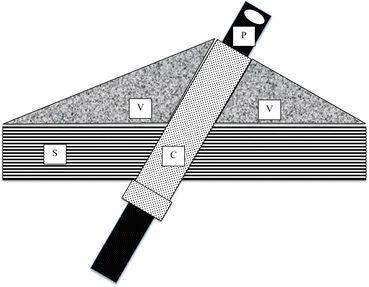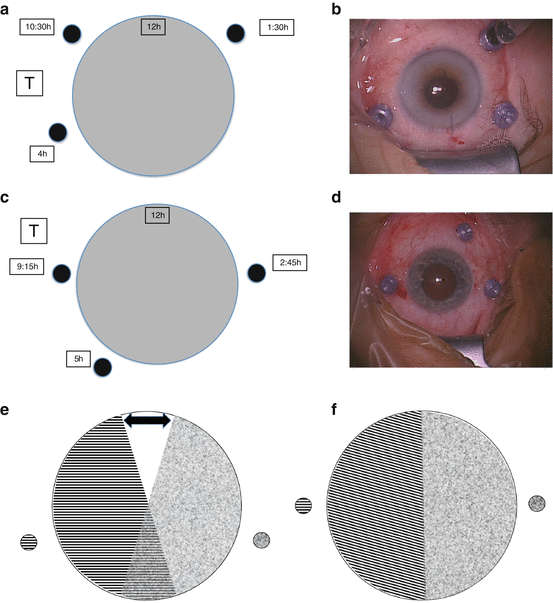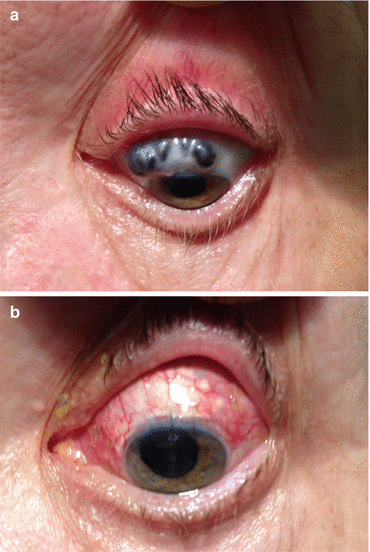(1)
St. Johns, FL, USA
(2)
Helen Keller Foundation for Research and Education, International Society of Ocular Trauma, Birmingham, AL, USA
(3)
Consultant and Vitreoretinal Surgeon, Milos Eye Hospital, Belgrade, Serbia
(4)
Consultant and Vitreoretinal Surgeon, Zagórskiego Eye Hospital, Cracow, Poland
21.1 Transconjunctival vs Conjunctiva-Opening Surgery
The traditional option, 20 g PPV with two or three conjunctival incisions, is fast disappearing.1 The trend is understandable since MIVS has many advantages and only a few disadvantages (see Table 21.1). Still, it must be emphasized that the main benefit of MIVS is not a reduced-sized sclerotomy.2
Table 21.1
23 g transconjunctival (MIVS) vs 20 g conjunctiva-opening PPV*
Variablea | 23 g | 20 g |
|---|---|---|
Patient comfort/perisurgical trauma | Greatly reduced trauma, consequently much greater comfort, for the patient. b It is also much less common to have subconjunctival bleeding (cosmesis) | |
Duration of surgery/speed of vitreous removalc | The preparation for and conclusion of (“previtrectomy” and “postvitrectomy” phases) the actual surgery are shorter | The removal of the vitreous itself is faster; the pre- and post-phases last longer |
Sclerotomy site in case of a late reoperation | Irrelevant; the site of the former sclerotomy is unlikely to be found | Avoid the previous site/s if possible |
Need to suture the sclerotomy/conjunctiva | If the wound architecture is correct (see Sect. 21.3 ), suturing of the sclerotomy is only rarely needed. Exceptions include: Reoperations (if the same location as before is used) Thin sclera (high myopia, scleritis, autoimmune diseases etc.) Long surgery Silicone oil implantation | Suturing is always necessary (unless some special technique is used to make the wound self-sealing), which can cause discomfort, astigmatism, and conjunctival scarring |
Vitreous incarceration into the sclerotomyd/vitrectomy at the sclerotomy site | This is virtually unavoidable (see Fig. 21.1 ) due to the presence of the cannula, unless the following measures are taken: In a pseudophakic eye, it is possible to clean the area underneath the sclerotomies by indenting the eyewall with the cannula itself. In a phakic eye, the only option is to remove the cannula, reintroduce the probe and perform “blind” PPV underneath the incision. The downside of this procedure is its increased chance for the wound to require suturing | The wound is always cleaned of any prolapsed vitreous; the probe must actually be pushed inside the incision to prevent any internal incarceration (which would not be apparent on the scleral surface) |
Tools with long blades | Any and every intraocular part of the tool must adhere to the limit of 0.65 mm in diameter. The solution if an oversized, long-blade instrument is needed is to remove the cannula or create a 20 g sclerotomy for that instrument | Any tool of any size and shape can be used in 20 g surgery, as long as its diameter does not exceed 0.9 mm: the instrument may have parts that exceed this dimension,f although this requires special techniques of tool insertion |
Changing the wound size | This is impossible. Tools of smaller size (g) can be used, but leakage through the cannula is inevitable. If a smaller cannula is inserted as replacement, the wound must be suture-constricted first | The wound can be temporally enlarged and then suture-constricted as required |
Difficulty with silicone oil of high viscosity | Significant or minimal, depending on the equipment | Minimal or none |
Instrument bendingg | Significant or minimal, depending on the equipment. The tendency to bend is roughly and inversely proportional with size | Minimal or none |
Instrument fragility | Much increased. It is crucial for the nurse to understand this, especially when working with forceps in the darkness of the OR (see Chap. 6 ); those who sterilize the instruments must also be warned about the tools’ fragility | Significant |
Intraoperative difficulties | There are no major differences between 20 g and MIVS,h although certain maneuvers such as lensectomy may be more difficult with 23 g; phacofragmentation is currently not available with gauges <23 | |
Intraoperative complications | No hard-proven difference | |
Complications due to instrument re/entries | The problem does not exist since all instruments are introduced through the cannula. There is no difference in instrument introduction whether the tool has a sharp or blunt tip | The wound may be damaged and an iatrogenic retinal break created, as the tools repeatedly penetrate the vitreous base. It is much more difficult and thus traumatic to push blunt tools through the sclerai |
Postoperative complications | It appears that now, with the early MIVS-related issues having been worked out, the risk is smaller with 23 g surgery | |
Cost | Higher in 23 g surgery | |
As mentioned in the Preface, all surgery-related issues discussed in this book are based on the 23 g approach.
21.2 Location of the Sclerotomies
The placement of the sclerotomies has huge implications for the techniques3 and prognosis of the surgery. A number of issues must be considered.
21.2.1 Distance from the Limbus
My routine for decades has been to place the sclerotomies 3.5 mm from the limbus, even if the eye is phakic. I have not encountered any difficulty or complication anteriorly (lens injury) or posteriorly (retinal injury). There are also exceptions to the routine:
Children. Table 21.2. shows the age-related recommendations.
Table 21.2
Limbus-to-sclerotomy distance of the pars plana incision in children
Age
Distance from the limbus, mm
≤6 months
1.5
6–12 months
2.0
1–2 years
2.5
2–6 years
3.0
≥6 years
3.5
Highly myopic eye. I place my sclerotomies at 4 mm if the axial length exceeds 26 mm.
The scleral wound should be perpendicular to the limbus (see below, Sect. 21.3); the distance is measured from the limbus to the proximal endpoint of the wound.
Pearl
Transillumination helps the surgeon identify the lighter pars plana from the darker ora serrata. Endoscopy via direct visual control allows the surgeon to locate the most optimal site of the (remaining 2) sclerotomies (see Sect. 17.3).
21.2.2 Location in Clock Hours
The placement of the cannulas has huge implications (see Figs. 21.1 and 21.2a, b, c, d) for the ease of performing the surgery as well as the prognosis, especially in the phakic eye. One of the most common errors a careful observer of VR surgeries4 notices is that the superior (working) sclerotomies are too close to each other. The typical advice is to place them “150° to 160° apart” (in reality they are even closer to each other). There are several disadvantages – and not a single advantage – with this arrangement:5



Fig. 21.1
Schematic representation of the difficulty of vitrectomy underneath the sclerotomy in MIVS. If inserted into the eye through a cannula (C) that sits in the sclera (S), the probe (P) cannot reach the vitreous (V) in the immediate vicinity surrounding the cannula. By changing the angle of the cannula, it is possible to remove a little more vitreous, but the only way to complete the vitrectomy is to reach the area from the opposite side of the eye or remove the cannula and reinsert the probe (neither option is shown here)

Fig. 21.2
The placement of the sclerotomies. (a) A common error is to place the working sclerotomies too close to each other (they are too superior; see the text for more details). T Temporal. (b) A clinical example, surgeon’s view. (c) Schematic representation of the implications of correct cannula placement: the working sclerotomies are just superior to the 3–9 o’clock line. Note that the infusion cannula has been moved closer to the 6 o’clock position. (d) A clinical example, surgeon’s view. (e) Schematic representation of the limitations caused by too-superior cannula placement. The shaded areas represent access to the vitreous base from the respective sclerotomy. The arrow shows the area that remains inaccessible in a phakic eye. (f) Correctly placed cannulas. The shaded areas represent access to the vitreous base from the respective sclerotomy. Even in a phakic eye, there is no area in the vitreous cavity that remains inaccessible to the probe
It prevents the surgeon from performing peripheral vitrectomy in the phakic eye inferiorly (see Figs. 21.2e, f).6
This is often the real reason why surgeons feel the need to place an SB on the eye with RD if the retinal break is inferior (see Sect. 54.5.2.2).
It makes it more difficult7 to access and work in the periphery superiorly.
Holding the hands closer together is less comfortable than keeping them further apart (as in the latter scenario with sclerotomies placed more inferiorly).
During a long surgery, less comfort can easily translate into less precision.
Placing the working sclerotomies very close to, but not right over,8 the 3 and 9 o’clock locations alleviates all these problems, without introducing any drawback. If the surgeon switches hands, he can access any location the vitreous cavity and do so comfortably.
The traditional site of the infusion cannula is at 4 o’clock. I place mine more toward 5 o’clock9 to make sure that there is enough room between the valves of the two temporal cannulas.
21.2.3 In Case of a Reoperation
This is a relatively common problem.
Q&A
Q
If an eye requires re-PPV, should the same site be used for the sclerotomies?
A
If the reoperation is performed early (within days/few weeks), the wound has not yet healed. If the original wound can easily be identified, it is preferable to reuse them. If the reoperation is performed at least several weeks after the previous surgery, any location is suitable.
In MIVS, it may be very difficult to identify the exact location of the previous sclerotomy without opening the conjunctiva – which would defeat one of the purposes of the transconjunctival approach. One advantage of always using identical clock hours during the primary PPV is to have a good idea where the sclerotomies should be found.
21.2.4 In Case of Scleral Thinning
If the sclera, for whatever reason (see Table 21.1 and Chap. 59), is visibly thin in the planned sclerotomy area, the site needs to be changed. An individual decision must be made to identify the most suitable and least inconvenient location. Scleroplasty (see Fig. 21.3) may be necessary even if the planned sclerotomy sites are outside the area of scleral thinning: the pressure needed to penetrate the sclera, inadvertent mechanical trauma during surgery, or the elevated IOP may cause a rupture with disastrous consequences.




